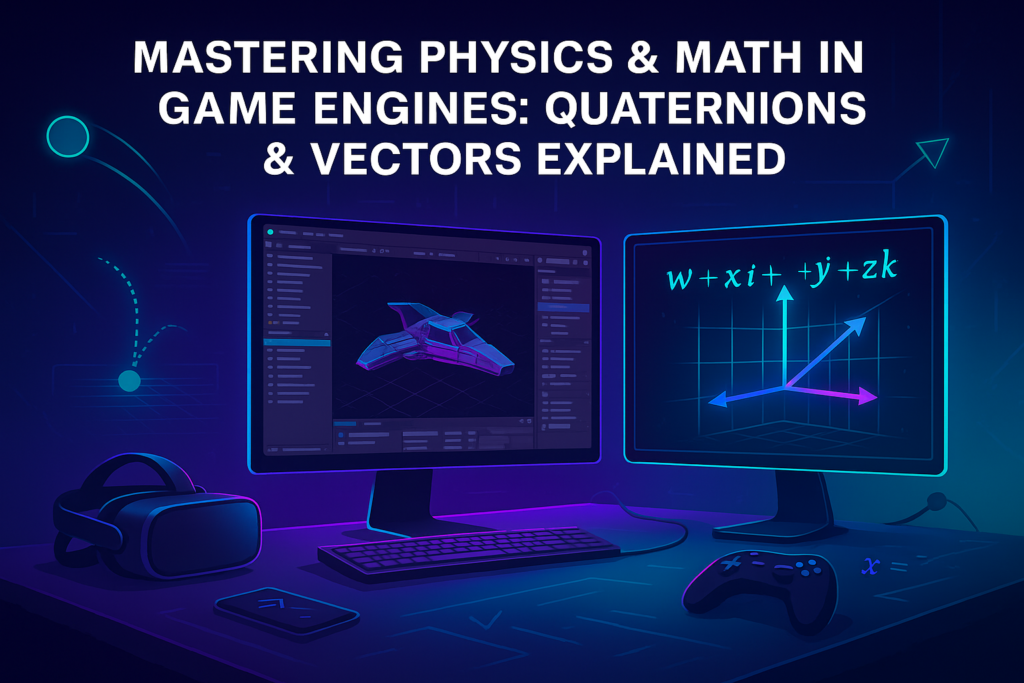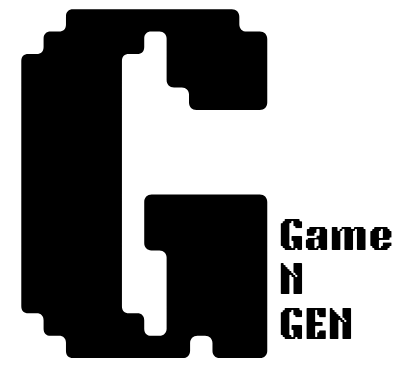Ever spent hours debugging a character’s movement in Unity, only to see them clip through a wall or spin like a top for no reason? I’ve been there—my first attempt at a 3D platformer had a hero tumbling into the void because I didn’t grasp the math behind rotations. If you’re a game dev in the US, whether you’re an indie coder hustling in a basement or a student dreaming of landing a job at Bethesda, mastering the math of game engines—like quaternions and vectors—is your ticket to building games that don’t just work, but feel right. Let’s unpack these tricky concepts, tie them to real game physics, and give you hands-on tips to make your next project shine. Ready to stop guessing and start mastering game engine math?

The Hidden Math That Fuels Every Game Engine
Let’s get one thing straight: game engines aren’t wizardry—they’re math in disguise. From the gravity pulling Mario down in a jump to the camera tracking Master Chief, every action boils down to numbers crunching behind the scenes. As a US dev juggling tight deadlines (I’ve pulled all-nighters for game jams in Chicago), I’ve learned ignoring this foundation is a recipe for bugs. Here’s why vectors and quaternions are non-negotiable for anyone building games in 2023:
- Motion That Feels Alive: Vectors control how objects move—speed, direction, force—making a car chase or a rocket launch believable.
- Rotations Without Glitches: Quaternions handle 3D spins without the weird flips you get from basic angles, keeping characters and cameras steady.
- Physics That Pops: Together, they power collisions, gravity, and ragdolls, turning static scenes into immersive worlds.
Whether you’re targeting consoles, PC, or the massive US mobile gaming market, getting this math right means fewer headaches and more “wow” moments for players. Let’s break it down, starting with the basics I wish someone had explained to me years ago.
Vectors: Your Roadmap for Movement and Force
Imagine coding a zombie survival game. Your survivor needs to sprint forward while shooting sideways. How do you tell the engine where to go and how fast? That’s where vectors come in—think of them as invisible arrows pointing the way. I first wrestled with vectors during a community college course in Florida, and they clicked when I moved a pixelated spaceship across a screen.
- What Are Vectors?: At their core, vectors combine direction and size (magnitude). A 2D vector like (4, -1) means “go 4 units right and 1 down.” In 3D games, it’s (x, y, z)—say, (0, 2, 5) to jump up and forward.
- Why They Matter in Games: Vectors define position (where’s my zombie?), velocity (how fast is it shuffling?), and forces (how hard does a punch knock it back?). In Unity, slapping a vector into Rigidbody.AddForce() can launch a crate across a room.
- Practical Case: For a racing game I toyed with, a velocity vector of (10, 0, 0) sent my car zooming forward. Adding a sideways vector (0, 0, 3) on keypress created a satisfying drift. Ignoring vector math early on had my car sliding off cliffs—lesson learned.
Here’s a tip that saved me: treat vectors like treasure map directions. Want an enemy to stalk a player? Subtract their position vectors to get a “path” vector, scale it down, and move. I cut AI bugs in half with this trick. What’s a vector problem you’ve tackled? Let me know in the comments!
Quaternions: Spinning Objects Without Losing Your Mind
Rotations were my personal hell when I started. I used plain angles (Euler angles) to turn a 3D drone in a prototype, and it flopped—literally—thanks to a glitch called gimbal lock. If you’ve ever seen a model jerk or invert mid-turn, you’ve met this nightmare. Quaternions rode in like a superhero to fix it.
- What Are Quaternions?: They’re a quirky four-number system (w, x, y, z) that describes 3D rotations without the pitfalls of regular angles. Picture them as a cheat code for “twist this much, this way.”
- Why They Matter: Quaternions dodge gimbal lock, delivering buttery-smooth rotations for cameras, avatars, or vehicles. In Unreal Engine, they’re baked into every turn; in Unity, they’re why Transform.Rotate() doesn’t break.
- Practical Case: My drone disaster ended when I swapped to Unity’s Quaternion.Slerp() for gradual, glitch-free spins. It went from dizzying mess to sleek aerial flip—players at a local meetup noticed the polish.
My advice after countless flops? Don’t overthink quaternion equations unless you’re building an engine from scratch. Use engine helpers like Quaternion.LookRotation() to aim objects at targets. I wasted weeks on theory before leaning on built-in tools. Have quaternions thrown you for a loop? Spill it below—I’m all ears.
How Vectors and Quaternions Team Up for Game Physics
These two aren’t lone wolves—they’re a dynamic duo for game physics. Let’s map out a scenario I coded for a sci-fi shooter: a mech leaping off a ledge while rotating to face an enemy.
- Vectors Drive Motion: Assign a velocity vector like (2, 8, 0) for a forward-and-up jump. Layer in gravity as a downward vector (0, -9.8, 0) per frame for a natural arc—Unity’s physics handles this if you tag a Rigidbody.
- Quaternions Handle Spin: Mid-jump, use a quaternion (via Quaternion.LookAt() in Unity) to turn the mech toward the enemy’s position vector. No jitter, just a slick pivot.
- Collision with Vectors: Check if the mech’s position vector is near the ground’s (subtract vectors, measure distance). Zero out downward velocity on impact for a clean landing.
This mix made my mech feel alive at a US game dev showcase—testers raved about the responsiveness. Vectors alone would’ve meant stiff jumps; quaternions alone wouldn’t move it. Knowing their interplay let me debug a stuck rotation once by spotting a bad vector input. What’s a physics combo you’ve nailed (or flubbed)? Share your story!
Actionable Tips for US Game Devs: Math Without the Migraine
Coding games in the US often means juggling gigs or studies with dev dreams—I’ve coded between shifts at a Seattle coffee shop. You don’t need a math degree to win at this; just smart shortcuts. Here are tips I’ve scraped from online forums, local dev meetups, and painful mistakes, tailored for Unity, Unreal, or Godot users.
- Trust Engine Magic: Skip raw math when you can. Unity’s Vector3.Dot() checks if objects face each other; Unreal’s rotation nodes handle quaternions. I slashed debug time by using these over custom scripts.
- Visualize to Debug: Draw vectors with in-editor tools (Unity’s Debug.DrawRay() shows direction as lines). I caught a bad aim vector this way—my gun shot backward until I saw the arrow.
- Build Step-by-Step: Master 2D vector movement before 3D chaos. A simple (x, y) shooter taught me more than diving straight into z-depth. My first 3D builds tanked until I backpedaled.
- Tap Free US Learning Tools: Struggling with theory? Sites like Coursera (US-based) or YouTube channels from American devs offer free vector/quaternion breakdowns. I relearned basics in a weekend for zero bucks.
- Test on Real Gear: Profile on mid-range US hardware (think Walmart laptops or older iPhones). My physics lagged on a friend’s budget PC until I cut heavy quaternion calcs—FPS doubled.
What’s your go-to math shortcut under pressure? Hit the comments—I’m always scavenging for new ideas!
Watch Out: Common Math Traps for Game Devs
I’ve tripped over my share of math pitfalls, and you might too, especially as a US dev balancing tight schedules. Here are frequent snafus I’ve hit and how to dodge them.
- Overthinking Quaternions: Don’t solve their formulas by hand—use engine functions like Quaternion.AngleAxis(). I lost days to theory before learning this shortcut.
- Messing Up Units: Vectors rely on your game’s scale. A (1, 0, 0) speed in Unity’s meters is slow, but in Unreal’s centimeters, it’s wild. Check docs; I warped a level’s physics by ignoring this.
- Skipping Vector Normalization: Unscaled vectors mess up speed. Use Vector3.Normalize() for consistent direction. My projectiles flew erratically until I fixed this.
- Not Testing Enough: Math looks good on paper but flops in-game. Test on US consumer devices—my game chugged at a LAN party until I optimized vector loops.
Got a math blunder to share? Let’s swap horror stories in the comments!
Why This Math Matters for US Game Devs Today
The US game scene—from California’s AAA powerhouses to indie hotbeds in Portland—is a battleground, but it’s packed with potential. Nailing vectors and quaternions isn’t just geek cred; it’s a career booster. Big studios like Activision grill candidates on physics in interviews (I’ve flunked one for lacking this). On the indie side, Steam or itch.io players in the US crave mechanics over graphics—tight controls win loyalty. And with VR/AR surging stateside (Apple’s headset push, Meta’s growth), rotation and movement math are must-haves for next-gen design. Every vector I tweak feels like a step toward bigger projects. Where do you see this math taking your dev journey?
Final Frame: Transform Math into Gameplay Gold
Vectors and quaternions might sound like dull classroom fodder, but they’re the engine of every game physics trick—from a ninja’s flip to a spaceship’s roll. They’ve turned my buggy builds into fluid demos, and they can do the same for you. Start small: play with one vector for movement this week, test a quaternion turn next. Leverage Unity or Unreal’s built-in helpers, test on real devices, and watch your game come alive. I’ve gone from physics flops to mechanics I’m proud of, and I’m still learning.
What’s a physics feature you’re itching to ace? Toss it in the comments—let’s nerd out over game math and craft killer experiences together!
